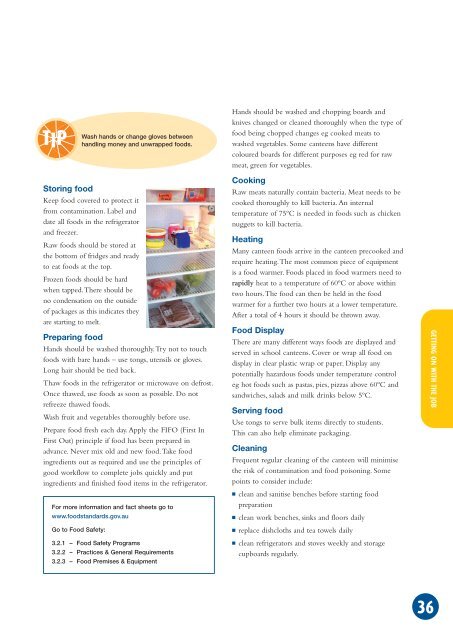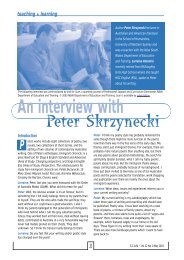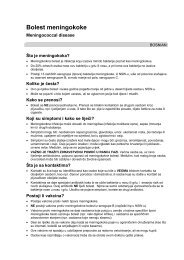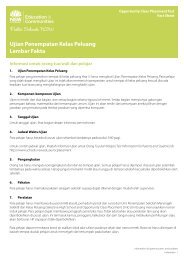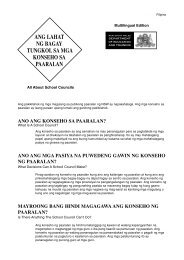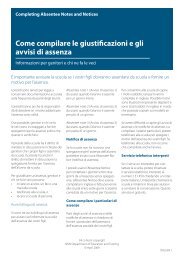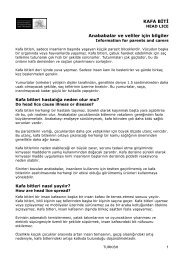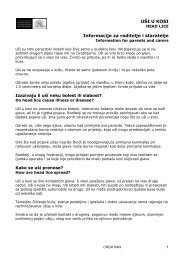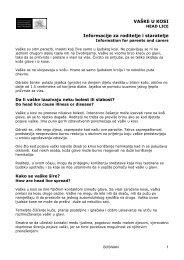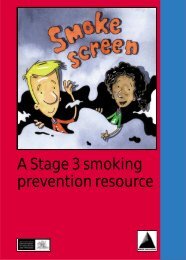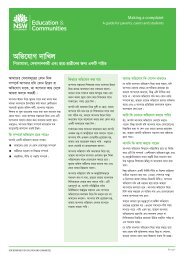Fresh Tastes Tool Kit - Public Schools NSW
Fresh Tastes Tool Kit - Public Schools NSW
Fresh Tastes Tool Kit - Public Schools NSW
You also want an ePaper? Increase the reach of your titles
YUMPU automatically turns print PDFs into web optimized ePapers that Google loves.
TIP<br />
Storing food<br />
Keep food covered to protect it<br />
from contamination. Label and<br />
date all foods in the refrigerator<br />
and freezer.<br />
Raw foods should be stored at<br />
the bottom of fridges and ready<br />
to eat foods at the top.<br />
Frozen foods should be hard<br />
when tapped.There should be<br />
no condensation on the outside<br />
of packages as this indicates they<br />
are starting to melt.<br />
Preparing food<br />
Hands should be washed thoroughly.Try not to touch<br />
foods with bare hands – use tongs, utensils or gloves.<br />
Long hair should be tied back.<br />
Thaw foods in the refrigerator or microwave on defrost.<br />
Once thawed, use foods as soon as possible. Do not<br />
refreeze thawed foods.<br />
Wash fruit and vegetables thoroughly before use.<br />
Prepare food fresh each day. Apply the FIFO (First In<br />
First Out) principle if food has been prepared in<br />
advance. Never mix old and new food.Take food<br />
ingredients out as required and use the principles of<br />
good workflow to complete jobs quickly and put<br />
ingredients and finished food items in the refrigerator.<br />
For more information and fact sheets go to<br />
www.foodstandards.gov.au<br />
Go to Food Safety:<br />
Wash hands or change gloves between<br />
handling money and unwrapped foods.<br />
3.2.1 – Food Safety Programs<br />
3.2.2 – Practices & General Requirements<br />
3.2.3 – Food Premises & Equipment<br />
Hands should be washed and chopping boards and<br />
knives changed or cleaned thoroughly when the type of<br />
food being chopped changes eg cooked meats to<br />
washed vegetables. Some canteens have different<br />
coloured boards for different purposes eg red for raw<br />
meat, green for vegetables.<br />
Cooking<br />
Raw meats naturally contain bacteria. Meat needs to be<br />
cooked thoroughly to kill bacteria. An internal<br />
temperature of 75ºC is needed in foods such as chicken<br />
nuggets to kill bacteria.<br />
Heating<br />
Many canteen foods arrive in the canteen precooked and<br />
require heating.The most common piece of equipment<br />
is a food warmer. Foods placed in food warmers need to<br />
rapidly heat to a temperature of 60ºC or above within<br />
two hours.The food can then be held in the food<br />
warmer for a further two hours at a lower temperature.<br />
After a total of 4 hours it should be thrown away.<br />
Food Display<br />
There are many different ways foods are displayed and<br />
served in school canteens. Cover or wrap all food on<br />
display in clear plastic wrap or paper. Display any<br />
potentially hazardous foods under temperature control<br />
eg hot foods such as pastas, pies, pizzas above 60ºC and<br />
sandwiches, salads and milk drinks below 5ºC.<br />
Serving food<br />
Use tongs to serve bulk items directly to students.<br />
This can also help eliminate packaging.<br />
Cleaning<br />
Frequent regular cleaning of the canteen will minimise<br />
the risk of contamination and food poisoning. Some<br />
points to consider include:<br />
■ clean and sanitise benches before starting food<br />
preparation<br />
■ clean work benches, sinks and floors daily<br />
■ replace dishcloths and tea towels daily<br />
■ clean refrigerators and stoves weekly and storage<br />
cupboards regularly.<br />
GETTING ON WITH THE JOB<br />
36


